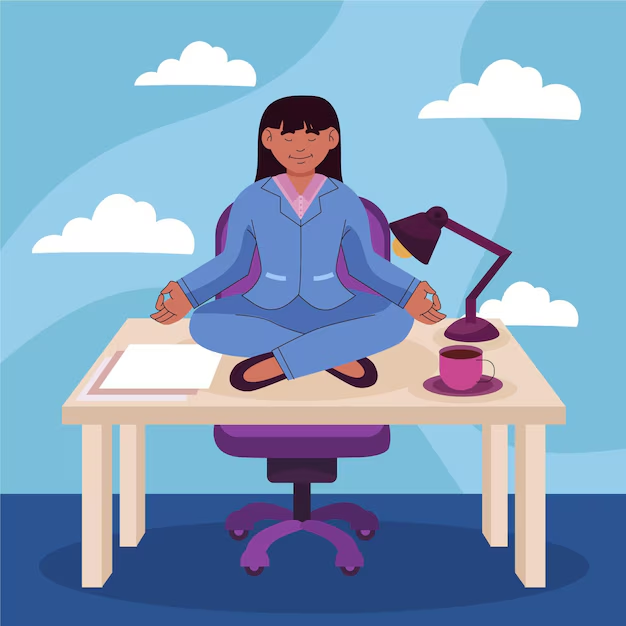Table of Contents

Introduction
In today’s fast-paced digital era, where the boundaries between work and personal life often seem to have dissolved, achieving work-life balance has become a quest of epic proportions. The term itself, while widely recognized, is often misunderstood or dismissed as an elusive ideal. Yet, the pursuit of this equilibrium is more critical than ever before.
Work-life balance refers to the harmonious coexistence of professional responsibilities and personal life, where neither aspect is neglected or overemphasized to the detriment of the other. This comprehensive blog post aims to dissect the concept of work-life balance, explore its historical evolution, delve into cultural and generational interpretations, understand its impact on mental health, recognize signs of poor balance, examine factors contributing to imbalances, outline the benefits of achieving balance, and provide actionable strategies to help you navigate the complexities of modern life.
Additionally, we’ll consider the evolving role of employers and the influence of technology on work-life balance, as well as examining real-life examples of those who have successfully struck a balance.
The Historical Evolution of Work-life balance benefits
The notion of work-life balance is a relatively modern concept. During the Industrial Revolution, long work hours and grueling conditions were the norm, with employees receiving little consideration for their personal lives. However, as labor laws evolved and society began to prioritize human rights, the concept of work-life balance began to take shape. The rise of the service sector, increased educational opportunities, and the emergence of dual-income households shifted societal values, prompting a demand for a more balanced approach to work and life.
Cultural and Generational Interpretations of Work-Life Balance
Cultural nuances significantly influence the way individuals perceive and pursue work-life balance. For instance, Scandinavian countries are renowned for their emphasis on work-life balance, with shorter work weeks and progressive parental leave policies that are almost unheard of in other parts of the world. These societies tend to prioritize leisure time, valuing a more equitable distribution of work and personal responsibilities. In contrast, other cultures, particularly in Asia, are often characterized by a more work-centric ethos, with longer work hours and a strong commitment to career advancement.
Generational differences also play a significant role. Millennials and Gen Z have redefined work-life balance, valuing flexibility and experiences over traditional job security. These generations often seek careers that align with their personal values and provide them with the opportunity to pursue their passions outside of the office. In contrast, older generations, such as Baby Boomers and Gen X, may have been accustomed to a more traditional work structure and are more likely to associate longer hours with dedication and success.

Core Components of Work-Life Balance
At its core, work-life balance is about managing three interrelated elements: time, energy, and priorities. Time management is essential, but it’s not enough. It’s about being present and fully engaged in both work and personal life. Energy management involves understanding when to work hard and when to rest, ensuring you have the physical and mental stamina to perform at your best in all areas of your life. Priority management requires you to establish clear boundaries and make conscious decisions about where to allocate your time and efforts, ensuring that you meet your professional commitments without sacrificing your personal well-being and relationships.
The Link Between Work-Life Balance and Mental Health
The psychological benefits of work-life balance are profound. When individuals are able to strike a balance between their professional and personal lives, they are less likely to experience chronic stress, which is a significant contributor to anxiety and depression. This balance allows for the mental downtime needed to recharge, fostering emotional resilience and a more positive outlook on life.
From a physical health standpoint, maintaining a balanced life can lead to improved sleep patterns, a stronger immune system, and a lower risk of developing chronic illnesses such as hypertension and cardiovascular disease. The mental strain of an unbalanced life can manifest in various physical symptoms, including headaches, fatigue, and a compromised immune system, making it essential to manage stress and prioritize self-care.
The Emotional Stability Work-Life Balance Brings to Relationships
Healthy relationships are a cornerstone of mental well-being. However, when work stress spills over into personal time, it can strain these connections, leading to misunderstandings and resentment. A well-managed work-life balance ensures that individuals have the capacity to invest quality time in their relationships, fostering emotional intimacy and support.
Signs of Poor Work-Life Balance
Chronic stress is one of the most telling signs of poor work-life balance. The constant pressure to meet work deadlines while juggling personal responsibilities can lead to burnout, a state of emotional, physical, and mental exhaustion. Declining productivity is another indicator, as overworking often results in diminished efficiency and creativity. Strained relationships, characterized by a lack of meaningful connection with family and friends, can also signal that your life is out of balance. Lastly, physical symptoms such as frequent illness, headaches, and fatigue are often the body’s way of signaling that something is amiss. Work-life balance benefits
Factors Contributing to Work-Life Imbalances
Several factors contribute to work-life imbalances. Workplace demands, including high-pressure environments and unrealistic expectations, can force individuals to prioritize their professional lives over their personal well-being. Technology and the constant connectivity it enables can make it challenging to disconnect from work, allowing work to infringe on personal time. Personal ambitions and perfectionism can also play a role, as the desire to succeed or fear of failure may lead to overcommitment and an unwillingness to take breaks. Additionally, a lack of clear boundaries can result in professional responsibilities encroaching on personal life, exacerbating the imbalance. Work-life balance benefits

The Impact of Poor Work-Life Balance on Mental Health
The mental health repercussions of a poor work-life balance are significant. Chronic stress can increase the risk of developing mental health disorders such as burnout, depression, and anxiety. It can also impact self-esteem and self-worth, as personal achievements and happiness are often relegated to the back burner. Moreover, neglecting personal relationships can lead to isolation and loneliness, further compounding mental health challenges. Work-life balance benefits
Career Consequences of Unbalanced Lives
Ironically, neglecting work-life balance can have negative consequences for career advancement. Chronic stress and burnout can lead to decreased performance and reduced innovation, hindering long-term career growth. Employees who fail to maintain balance may miss out on promotions or opportunities due to their inability to perform at their best or sustain their work over time. Work-life balance benefits
The Benefits of Work-Life Balance for Mental Well-Being
On the flip side, achieving a healthy work-life balance can lead to numerous mental health benefits. Enhanced productivity is one of the most notable outcomes, as individuals who are well-rested and emotionally stable tend to be more focused and efficient in the workplace. Better stress management is another advantage, as balancing work and personal life reduces the overall stress load. Stronger relationships and personal fulfillment are also key benefits, contributing to a more content and rounded life. Work-life balance benefits
Strategies to Achieve Work-Life Balance
To conquer the challenges of achieving work-life balance, consider the following strategies:
Personal Strategies
- Time Management: Employ tools such as planners or productivity apps to organize your tasks and set clear priorities. This helps ensure that you are making the most of your time and not stretching yourself too thin. Work-life balance benefits
- Set Boundaries: Clearly define when you are working and when you are not. This might involve setting specific work hours, avoiding emails or work calls during personal time, and creating a dedicated workspace to minimize distractions.
- Self-Care: Engage in activities that replenish your mental and physical health, such as yoga, meditation, or other hobbies that provide an outlet for stress relief and personal enrichment.Work-life balance benefits
Professional Strategies
- Flexible Work Arrangements: Discuss options like remote work or flexible hours with your employer. These can help you manage your time more effectively and reduce the stress associated with commuting and inflexible work schedules.
- Delegate: Recognize when you can share responsibilities with colleagues. Delegation is not only a sign of good leadership but also a way to prevent burnout by distributing workloads more evenly.
- Utilize Workplace Wellness Programs: Many employers offer mental health resources such as counseling services or stress management workshops. Take advantage of these benefits to support your overall well-being. Work-life balance benefits
Community and Support Systems
- Lean on Family and Friends: Building a strong support network is crucial for maintaining balance. Sharing your challenges and successes with loved ones can provide emotional relief and encourage healthy habits.
- Peer Networks: Join groups or communities that prioritize work-life balance. Sharing experiences and strategies with like-minded individuals can be both motivating and informative.Work-life balance benefits
The Role of Employers in Promoting Work-Life Balance
Employers have a vital role to play in fostering a balanced work environment. A supportive workplace culture that values employee well-being can go a long way in reducing stress and improving job satisfaction. Companies that provide benefits such as mental health counseling, fitness programs, and generous leave policies demonstrate a commitment to their employees’ holistic health, leading to happier, more productive workers. Work-life balance benefits
Real-Life Stories and Examples
Learning from the experiences of others can be incredibly motivating. Sharing the successes of individuals and companies that have achieved work-life balance can provide a blueprint for your own journey. For example, a working parent might find inspiration in someone who has managed to maintain a thriving career while still making time for their children and personal interests. An entrepreneur may find solace in the story of a fellow business owner who overcame burnout by setting clear boundaries and prioritizing self-care. Work-life balance benefits
Work-Life Balance in a Post-Pandemic World
The COVID-19 pandemic has dramatically altered the landscape of work. The widespread adoption of remote work has introduced new challenges to maintaining balance, as the lines between work and home have become increasingly blurred. However, it has also presented opportunities for greater flexibility and the potential for a more balanced approach to work.
- Remote Work: While working from home allows for greater flexibility, it’s essential to set clear work hours and establish boundaries to avoid burnout.
- Hybrid Models: As offices reopen, balancing in-office and remote work will require careful planning to prevent work from dominating personal life. Work-life balance benefits
- Trends in Flexibility: Post-pandemic, companies are increasingly recognizing the importance of work-life balance. This shift is reflected in new policies that prioritize employee well-being and flexibility. Work-life balance benefits
The Role of Technology in Work-Life Balance
Technology is a double-edged sword in the quest for work-life balance. While productivity tools and apps can help streamline tasks and manage time more effectively, the constant connectivity they provide can also lead to digital burnout. Work-life balance benefits
Positive Contributions
- Productivity Tools: Technology can help you manage your time more efficiently, allowing you to complete work tasks more effectively and freeing up time for personal pursuits. Work-life balance benefits
- Virtual Meetings: Online meetings reduce the need for commuting, offering more time for personal activities. Work-life balance benefits Work-life balance benefits
Challenges
- Constant Notifications: Being “always on” can be detrimental to mental health, making it challenging to disconnect from work. Work-life balance benefits
- Solution: Set boundaries by turning off work notifications during personal time. Use technology mindfully to enhance your life, not control it. Work-life balance benefits
Cultural Comparisons and Learning from the Best
Looking at work-life balance across cultures, it’s evident that some societies are more adept at achieving this elusive equilibrium. For example, countries like Denmark emphasize “hygge” (coziness) and community, offering valuable lessons in integrating work and leisure.
Overcoming Challenges in Maintaining Work-Life Balance
Life transitions, such as becoming a parent or moving, can disrupt even the most carefully crafted balance. It’s essential to adapt and plan for these changes to sustain a balanced lifestyle. Societal pressures can also make it challenging to maintain work-life balance, but by focusing on personal needs and setting realistic expectations, it’s possible to overcome these hurdles.

Conclusion
Work-life balance is not a static goal but an ongoing journey that requires consistent effort and adjustment. The pursuit of balance is deeply personal and will look different for everyone. However, the mental, emotional, and physical benefits are universal. By embracing change and making a commitment to well-being, you can create a life that honors both your professional ambitions and your personal happiness. Invest in the strategies outlined here and watch as the quality of your life transforms before your eyes. Remember, Work-life balance benefits